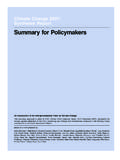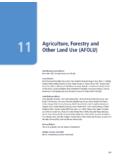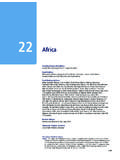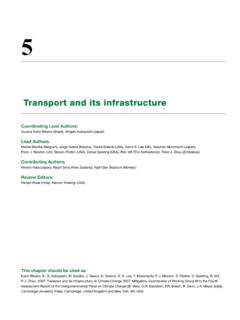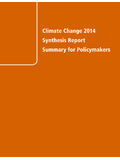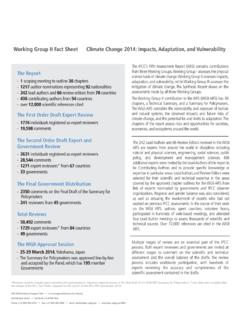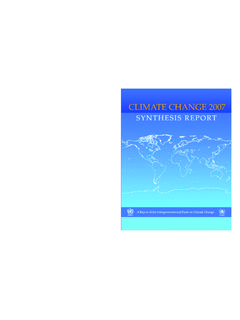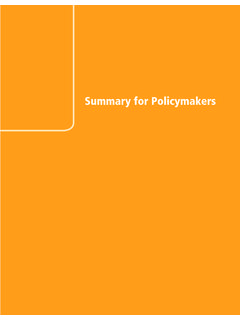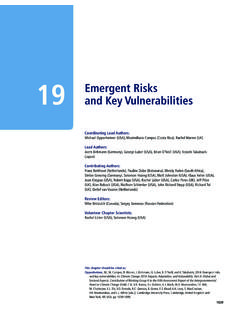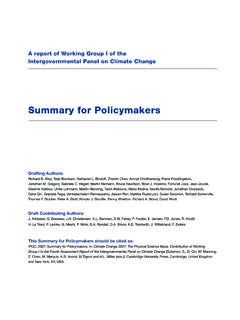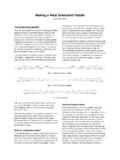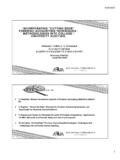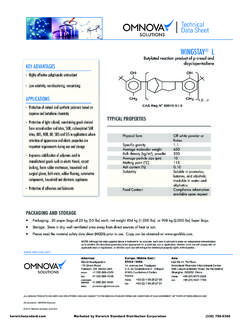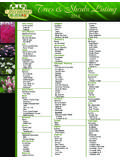Transcription of INTERGOVERNMENTAL PANEL ON climate change
1 WORKING GROUP II CONTRIBUTION TO THE FIFTH ASSESSMENT REPORT OF THE INTERGOVERNMENTAL PANEL ON climate CHANGEWG IIINTERGOVERNMENTAL PANEL ON climate change1 Summaryfor PolicymakersSPMThis Summary for Policymakers should be cited as:IPCC, 2014: Summary for policymakers. In: climate change 2014: Impacts, Adaptation, and A: Global and Sectoral Aspects. Contribution of Working Group II to the Fifth Assessment Report of theIntergovernmental PANEL on climate change [Field, , Barros, Dokken, Mach, Mastrandrea, Bilir, M. Chatterjee, Ebi, Estrada, Genova, B. Girma, Kissel, Levy, S. MacCracken, Mastrandrea, and White (eds.)]. Cambridge University Press, Cambridge, United Kingdom and NewYork, NY, USA, pp. Authors:Christopher B. Field (USA), Vicente R. Barros (Argentina), Michael D. Mastrandrea (USA),Katharine J. Mach (USA), Mohamed Abdrabo (Egypt), W. Neil Adger (UK),Yury A. Anokhin (Russian Federation), Oleg A. Anisimov (Russian Federation), Douglas J.
2 Arent(USA), Jonathon Barnett (Australia), Virginia R. Burkett (USA), Rongshuo Cai (China),Monalisa Chatterjee (USA/India), Stewart J. Cohen (Canada), Wolfgang Cramer(Germany/France), Purnamita Dasgupta (India), Debra J. Davidson (Canada), Fatima Denton(Gambia), Petra D ll (Germany), Kirstin Dow (USA), Yasuaki Hijioka (Japan),Ove Hoegh-Guldberg (Australia), Richard G. Jones (UK), Roger N. Jones (Australia),Roger L. Kitching (Australia), R. Sari Kovats (UK), Joan Nymand Larsen (Iceland), Erda Lin(China), David B. Lobell (USA), I igo J. Losada (Spain), Graciela O. Magrin (Argentina),Jos A. Marengo (Brazil), Anil Markandya (Spain), Bruce A. McCarl (USA), Roger F. McLean(Australia), Linda O. Mearns (USA), Guy F. Midgley (South Africa), Nobuo Mimura (Japan),John F. Morton (UK), Isabelle Niang (Senegal), Ian R. Noble (Australia), Leonard A. Nurse(Barbados), Karen L. O Brien (Norway), Taikan Oki (Japan), Lennart Olsson (Sweden),Michael Oppenheimer (USA), Jonathan T.
3 Overpeck (USA), Joy J. Pereira (Malaysia),Elvira S. Poloczanska (Australia), John R. Porter (Denmark), Hans-O. P rtner (Germany),Michael J. Prather (USA), Roger S. Pulwarty (USA), Andy Reisinger (New Zealand),Aromar Revi (India), Patricia Romero-Lankao (Mexico), Oliver C. Ruppel (Namibia),David E. Satterthwaite (UK), Daniela N. Schmidt (UK), Josef Settele (Germany), Kirk R. Smith(USA), D ith A. Stone (Canada/South Africa/USA), Avelino G. Suarez (Cuba), Petra Tschakert(USA), Riccardo Valentini (Italy), Alicia Villamizar (Venezuela), Rachel Warren (UK),Thomas J. Wilbanks (USA), Poh Poh Wong (Singapore), Alistair Woodward (New Zealand),Gary W. Yohe (USA)Summary for Policymakers2 ContentsAssessing and Managing the Risks of climate change .. 3 Background Box Context for the Assessment .. 4 Background Box Terms Central for Understanding the Summary .. 5 Background Box Communication of the Degree of Certainty in Assessment Findings.
4 6 A: Observed Impacts, Vulnerability, and Adaptation in a Complex and Changing World .. 4 A-1. Observed Impacts, Vulnerability, and Exposure .. 4 A-2. Adaptation Experience .. 8 A-3. The Decision-making Context .. 9B: Future Risks and Opportunities for Adaptation ..11 B-1. Key Risks across Sectors and Regions ..11 Assessment Box Human Interference with the climate System ..12 B-2. Sectoral Risks and Potential for Adaptation ..14 B-3. Regional Key Risks and Potential for Adaptation ..20 Assessment Box Regional Key Risks ..21C: Managing Future Risks and Building Resilience ..25 C-1. Principles for Effective Adaptation ..25 C-2. climate -resilient Pathways and Transformation ..28 Supplementary Material ..30 SPM3 ASSESSING AND MANAGING THE RISKS OF climate CHANGEH uman interference with the climate system is occurring,1and climate change poses risks for human and natural systems (Figure ).
5 Theassessment of impacts, adaptation, and vulnerability in the Working Group II contribution to the IPCC s Fifth Assessment Report (WGII AR5)evaluates how patterns of risks and potential benefits are shifting due to climate change . It considers how impacts and risks related to climatechange can be reduced and managed through adaptation and mitigation. The report assesses needs, options, opportunities, constraints,resilience, limits, and other aspects associated with change involves complex interactions and changing likelihoods of diverse impacts. A focus on risk, which is new in this report, supportsdecision making in the context of climate change and complements other elements of the report. People and societies may perceive or rankrisks and potential benefits differently, given diverse values and to past WGII reports, the WGII AR5 assesses a substantially larger knowledge base of relevant scientific, technical, and socioeconomicliterature.
6 Increased literature has facilitated comprehensive assessment across a broader set of topics and sectors, with expanded coverage ofhuman systems, adaptation, and the ocean. See Background Box A of this summary characterizes observed impacts, vulnerability and exposure, and adaptive responses to date. Section B examines futurerisks and potential benefits. Section C considers principles for effective adaptation and the broader interactions among adaptation, mitigation,EMISSIONS and Land-use ChangeVulnerabilityExposureRISKH azardsAnthropogenic climate ChangeSocioeconomic PathwaysAdaptation and Mitigation ActionsGovernanceIMPACTSN atural VariabilitySOCIOECONOMICPROCESSESCLIMATE RF igure | Illustration of the core concepts of the WGII AR5. Risk of climate -related impacts results from the interaction of climate -related hazards (including hazardous events and trends) with the vulnerability and exposure of human and natural systems. Changes in both the climate system (left) and socioeconomic processes including adaptation and mitigation (right) are drivers of hazards, exposure, and vulnerability.
7 [ , Figure 19-1]Summary for Policymakers1A key finding of the WGI AR5 is, It is extremely likelythat human influence has been the dominant cause of the observed warming since the mid-20th century. [WGI AR5 SPM Section , , , , ] , Figure 1-1 SPMS ummary for Policymakers4and sustainable development. Background Box defines central concepts, and Background Box introduces terms used to conveythe degree of certainty in key findings. Chapter references in brackets and in footnotes indicate support for findings, figures, and : OBSERVED IMPACTS, VULNERABILITY, AND ADAPTATION IN A COMPLEX AND CHANGING WORLDA-1. Observed Impacts, Vulnerability, and ExposureIn recent decades, changes in climate have caused impacts on natural and human systems on all continents and across theoceans. Evidence of climate - change impacts is strongest and most comprehensive for natural systems. Some impacts on human systems havealso been attributed5to climate change , with a major or minor contribution of climate change distinguishable from other influences.
8 SeeFigure Attribution of observed impacts in the WGII AR5 generally links responses of natural and human systems to observed climatechange, regardless of its many regions, changing precipitation or melting snow and ice are altering hydrological systems, affecting water resources interms of quantity and quality (medium confidence). Glaciers continue to shrink almost worldwide due to climate change (high confidence),affecting runoff and water resources downstream (medium confidence). climate change is causing permafrost warming and thawing in high-latitude regions and in high-elevation regions (high confidence).7 Many terrestrial, freshwater, and marine species have shifted their geographic ranges, seasonal activities, migration patterns,abundances, and species interactions in response to ongoing climate change (high confidence).See Figure While only a few recentspecies extinctions have been attributed as yet to climate change (high confidence), natural global climate change at rates slower than currentanthropogenic climate change caused significant ecosystem shifts and species extinctions during the past millions of years (high confidence).
9 8 Based on many studies covering a wide range of regions and crops, negative impacts of climate change on crop yields havebeen more common than positive impacts (high confidence). The smaller number of studies showing positive impacts relate mainly toBackground Box | Context for the Assessment For the past 2 decades, IPCC s Working Group II has developed assessments of climate - change impacts, adaptation, and WGII AR5 builds from the WGII contribution to the IPCC s Fourth Assessment Report (WGII AR4), published in 2007, and theSpecial Report on Managing the Risks of Extreme Events and Disasters to Advance climate change Adaptation(SREX), published in2012. It follows the Working Group I contribution to the AR5 (WGI AR5).3 The number of scientific publications available for assessing climate - change impacts, adaptation, and vulnerability more thandoubled between 2005 and 2010, with especially rapid increases in publications related to adaptation.
10 Authorship of climate -changepublications from developing countries has increased, although it still represents a small fraction of the WGII AR5 is presented in two parts (Part A: Global and Sectoral Aspects, and Part B: Regional Aspects), reflecting the expandedliterature basis and multidisciplinary approach, increased focus on societal impacts and responses, and continued regionallycomprehensive , Figure 1-15 The term attributionis used differently in WGI and WGII. Attribution in WGII considers the links between impacts on natural and human systems and observed climate change ,regardless of its cause. By comparison, attribution in WGI quantifies the links between observed climate change and human activity, as well as other external climate , , , , , , , , Tables 3-1 and 25-1, Figures 18-2 and , , , , , , , , , , , Boxes 4-2, 4-3, 25-3, CC-CR, and CC-MBSPM5 Summary for PolicymakersBackground Box | Terms Central for Understanding the Summary9 climate change : climate change refers to a change in the state of the climate that can be identified ( , by using statistical tests)by changes in the mean and/or the variability of its properties, and that persists for an extended period, typically decades or change may be due to natural internal processes or external forcings such as modulations of the solar cycles, volcaniceruptions, and persistent anthropogenic changes in the composition of the atmosphere or in land use.
